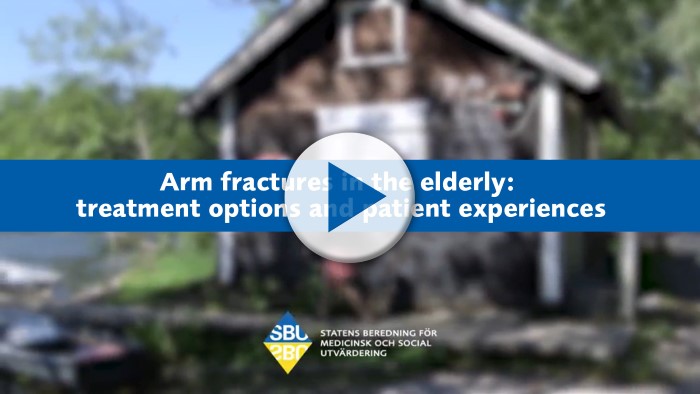This publication was published more than 5 years ago. The state of knowledge may have changed.
Treatment options of arm fractures in the elderly
A systematic review and assessment of the medical, economic, social and ethical aspects
The Swedish Agency for Health Technology Assessment and Assessment of Social Services (SBU) has evaluated the effects, complications, health economic aspects and ethical considerations of arm fractures treatment in the elderly with a mean age above 60 years. The project originates from a proposal from the Swedish Orthopaedic Association. The systematic review also includes studies on how patients with osteoporosis experience participation in their care and their encounters with health care professionals.
- Using plaster casts to non-surgically immobilise less complex wrist (distal radius) fractures appears to result in the same functional outcome as surgical techniques, involving open reduction and internal fixation (ORIF) of a metal plate to the bone (plate fixation) or fixing external supports to the bone through small incisions in the skin (external fixation or pinning), at one year follow-up. Treatment with plaster casting appears to result in grip strength equivalent to that achieved with external fixation/pinning methods. Quality of life outcomes appear to be as good or better with external fixation/pinning. It is increasingly common for patients with wrist fractures to be surgically treated, at a higher treatment cost.
- Treating less complex wrist (distal radius) fractures with surgery using either plate fixation or external fixation methods appears to result in equivalent function, grip strength and quality of life, at one year follow-up. Plate fixation has become more common, even though more patients treated this way require reoperation and this treatment method costs more than external fixation or pinning.
- Using a sling to support the arm of patients with less complex shoulder (proximal humerus) fractures appears to result in the same levels of function and quality of life as the surgical treatment ORIF, at one year follow-up. Non-surgical treatment results in the same functional outcome as a partial shoulder replacement (hemiarthroplasty) at one year follow-up. However, the trend in Sweden is that patients with shoulder fractures are being treated surgically more often, at a higher treatment cost.
- Surgical treatment of less complex fractures of the wrist and shoulder may lead to unnecessary surgery. This could lead to less resources being available for other health care interventions.
- In their encounters with the health care system, patients with osteoporosis perceive that they often receive insufficient, incorrect or contradictory information, which complicates their health care decision making process. Patients with osteoporosis perceive that they are often left to themselves with insufficient information on how to manage their health. They want to be taken seriously as individuals.
- Several evidence gaps were identified. More randomised controlled studies comparing common treatment methods for arm fractures in the elderly are needed. The studies must have sufficient power, accurately describe the severity of the fractures, use validated instruments to measure outcomes and follow patients up for at least one year. Aspects of health economics also need to be highlighted in future studies. Studies that describe how elderly patients who specifically had arm fractures perceive their health care experience are needed. Future studies should also report the results from the perspective of both men and women.
Project group
Experts
- Carl Ekholm (Associate Professor, University of Gothenburg and Senior Consultant in Orthopedics, Sahlgrenska University Hospital, Gothenburg)
- Per Olof Josefsson (Associate Professor, Lund University and Senior Consultant in Orthopedics, Skåne University Hospital, Malmö)
- Cecilia Mellstrand Navarro (Ph.D., Karolinska Institutet and Consultant in Orthopedics, Registrar in Hand Surgery, Stockholm South General Hospital, Stockholm)
- Peter Nordström (Professor, Umeå University and Senior Consultant in Geriatrics and Internal Medicine, University Hospital of Umeå, Umeå)
- Lars-Eric Olsson (Associate Professor, University of Gothenburg and Registered Nurse, Sahlgrenska University Hospital, Gothenburg)
- Lena Zidén (Ph.D., University of Gothenburg and Registered Physiotherapist, Sahlgrenska University Hospital, Gothenburg)
SBU
- Karin Stenström (Project Manager)
- Maria Ahlberg/Sara Fundell/Therese Kedebring (Project Administrators)
- Agneta Brolund (Information Specialist)
- Emin Hoxha Ekström/Emelie Heintz (Health Economists)
- Lina Leander/Agneta Pettersson/Marie Österberg (Assistant Project Managers)
Article from SBU's newsletter Medical and Social Science & Practice
Arm fracture: Recovery often similar without costly invasive surgery
Fractures of the wrist and shoulder are increasingly operated on with metal plates, which are more expensive than other methods. But moderate dislocations may respond just as well to the alternatives. The SBU assessment points the way to an approach that would reverse the trend and ensure equal quality of care at lower costs.
Read the articleMore on the subject
Scientific Articles
Mellstrand Navarro C, Brolund A, Ekholm C, Heintz E, Hoxha Ekstrom E, Josefsson PO, et al. Treatment of humerus fractures in the elderly: A systematic review covering effectiveness, safety, economic aspects and evolution of practice. PLoS One 2018;13:e0207815. Open Access
Mellstrand Navarro C, Brolund A, Ekholm C, Heintz E, Hoxha Ekstrom E, Josefsson PO, et al. Treatment of radius or ulna fractures in the elderly: A systematic review covering effectiveness, safety, economic aspects and current practice. PloS one. 2019;14(3):e0214362. Open Access

 Swedish Agency for Health Technology Assessment and Assessment of Social Services
Swedish Agency for Health Technology Assessment and Assessment of Social Services
 Share on Facebook
Share on Facebook
 Share on LinkedIn
Share on LinkedIn
 Share via Email
Share via Email
